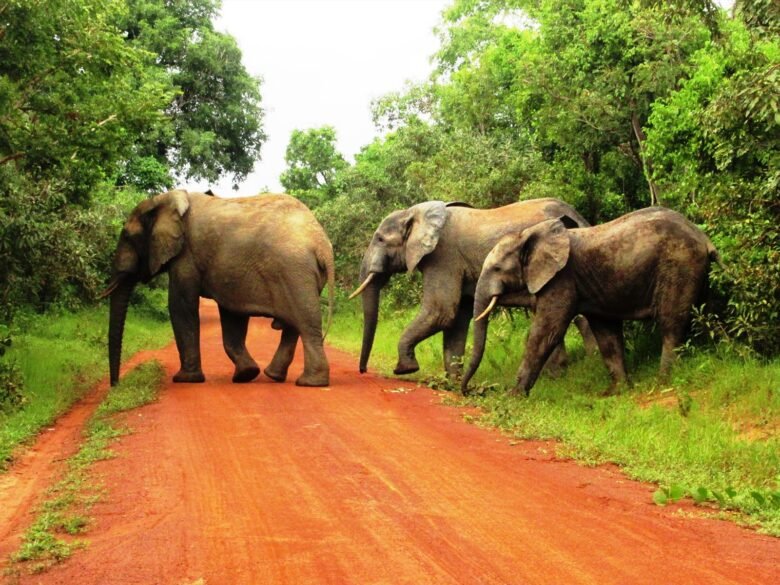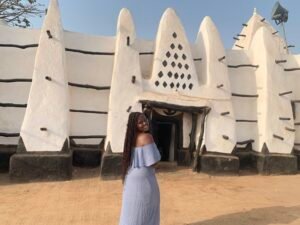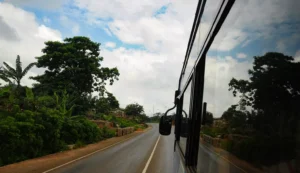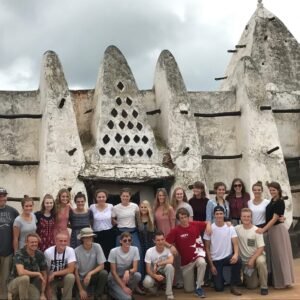Ghana may not be the first country that comes to mind for an African safari, but it offers surprisingly rich and accessible wildlife experiences. From elephant sightings in the savannahs of Mole to baboons at the edge of Accra, Ghana’s national parks and reserves are a perfect blend of adventure and authenticity—without the high prices or tourist crowds you might find in East or Southern Africa.
This guide explores the top safari and wildlife destinations in Ghana, what to expect at each, how to get there, and tips for making the most of your journey.
1. Mole National Park – Ghana’s Premier Safari Destination
Location: Northern Region, near Damongo
Size: 4,840 km²
Best Time to Visit: December–April (dry season)
Mole is Ghana’s largest and most famous national park—and for good reason. It offers affordable walking and driving safaris, opportunities to see African elephants up close, and stunning savannah landscapes.
What You’ll See:
- Elephants (the park’s main attraction)
- Antelopes (kob, bushbuck, waterbuck)
- Warthogs
- Olive baboons and patas monkeys
- Birds (over 300 species, including hornbills and kingfishers)
- Occasional sightings of hyenas and leopards
Safari Options:
- Walking safaris with armed guides (GHS 60–100)
- Jeep safaris (GHS 250–400 for vehicle hire, shared among guests)
- Night drives available on request for spotting nocturnal animals
Accommodation:
- Zaina Lodge (luxury eco-lodge)
- Mole Motel (mid-range)
- Budget guesthouses in nearby Larabanga
Travel Tip: Combine your visit with a stop at the ancient Larabanga Mosque and Mognori Eco-Village for cultural immersion.
Getting There: Bus or flight to Tamale, then 3–4 hours by road to Mole. Shared taxis or tour packages are available from Tamale.
2. Kakum National Park – Canopy Walk & Forest Wildlife
Location: Central Region, near Cape Coast
Size: 375 km²
Best Time to Visit: Year-round
While not a traditional safari destination, Kakum offers a unique rainforest experience and the famous canopy walkway, suspended 30 meters above the forest floor.
What You’ll See:
- Diana monkeys and colobus monkeys
- Duikers (small antelopes)
- Over 200 species of birds
- Rare butterflies and forest reptiles
Activities:
- Canopy walkway tour (GHS 60–80)
- Nature hikes with guides
- Birding tours (morning preferred)
- Medicinal plant and cultural interpretation walks
Accommodation:
- Hans Cottage Botel (with crocodile pond)
- Rainforest Lodge
- On-site treehouse (overnight stays with prior booking)
Travel Tip: Visit early in the morning or late in the afternoon when wildlife is most active.
Nearby Sites: Combine with visits to Cape Coast Castle and Elmina Castle for a full historical and natural itinerary.
3. Shai Hills Resource Reserve – Safari Near Accra
Location: Greater Accra Region, about 45 minutes from Accra
Size: 51 km²
Best Time to Visit: November–April
Shai Hills is the most accessible wildlife park from Accra and ideal for day trips or weekend escapes.
What You’ll See:
- Olive baboons (very common)
- Antelope species (bushbuck, kob)
- Monitor lizards, rock hyraxes
- Over 150 bird species
- Bat colonies in the caves
Activities:
- Game drives
- Rock climbing and cave exploration
- Guided hiking
- Birdwatching
Cultural Element:
Shai Hills contains ancestral caves used by the Shai people before British colonial eviction in the 1890s. Tours often blend wildlife with anthropology.
Entry Cost:
- GHS 20–60 for park entrance and guides
- Vehicle access may require an additional fee
Travel Tip: Bring binoculars and wear hiking shoes. The terrain is rocky and dusty.
4. Digya National Park – Ghana’s Hidden Wilderness
Location: Brong-Ahafo Region, by Lake Volta
Size: 3,743 km²
Best Time to Visit: December–March
Digya is Ghana’s oldest national park, established in 1900, yet it remains underdeveloped and off-the-beaten-path. Its remote setting means few crowds and vast wilderness.
What You’ll See:
- African manatees (in Lake Volta)
- Elephants (rarely seen but present)
- Buffaloes
- Numerous antelope species
- Monkeys and birdlife
Why Visit:
- True adventure for those looking for unspoiled nature
- Great for boating safaris on Lake Volta (with prior arrangement)
- Camping options available for seasoned travelers
Travel Tip: No formal infrastructure; arrange guides and transport in advance through Ghana Wildlife Division or regional tourism offices.
5. Ankasa Conservation Area – Rainforest Biodiversity
Location: Western Region, near the Côte d’Ivoire border
Size: 500 km²
Best Time to Visit: November–April
Ankasa is Ghana’s most biodiverse rainforest, ideal for ecotourists and researchers.
What You’ll See:
- Forest elephants (rare)
- Chimpanzees and monkeys
- Rare bird species (e.g., white-breasted guinea fowl)
- Over 800 vascular plant species
Activities:
- Jungle trekking
- Birdwatching tours
- Camping in designated forest clearings
Getting There: Best accessed from Takoradi or Axim. The park is remote, and 4WD vehicles are recommended.
Travel Tip: Facilities are minimal—bring your own supplies, and plan for wet, slippery trails.
6. Bomfobiri Wildlife Sanctuary – A Birding Paradise
Location: Ashanti Region, near Kumawu
Size: 53 km²
Best Time to Visit: November–March
Though lesser-known, Bomfobiri is a haven for bird watchers and waterfall lovers.
What You’ll See:
- Over 200 bird species
- Baboons and monkeys
- Occasional sightings of antelope and reptiles
- The scenic Bomfobiri Falls
Activities:
- Guided birding walks
- Waterfall hikes
- Nature observation
It’s an intimate sanctuary with low traffic, making it ideal for nature photography and quiet exploration.
7. Owabi Wildlife Sanctuary – Urban Wildlife Spot
Location: Near Kumasi, Ashanti Region
Size: 13 km²
Best Time to Visit: Morning hours, year-round
Owabi is the only inland Ramsar site in Ghana and serves as both a wildlife sanctuary and water reservoir.
What You’ll See:
- Monkeys, squirrels, bush pigs
- Rich wetland birdlife (herons, egrets, kingfishers)
- Butterflies and aquatic flora
Ideal For: A half-day escape from Kumasi with minimal travel time.
Safari Costs in Ghana – What to Budget
| Destination | Entry Fee (GHS) | Safari Cost (GHS) | Accommodation (USD) |
|---|---|---|---|
| Mole National Park | 50–100 | 60–400 (shared jeep) | $15–$300 |
| Kakum National Park | 60–80 | Included in ticket | $10–$150 |
| Shai Hills Reserve | 20–60 | 50–100 (guide) | N/A (day trip) |
| Ankasa | 20–50 | Guide negotiable | $15–$60 (camping) |
| Digya | 20–40 | Boat extra | $10–$50 (DIY stays) |
What to Pack for a Wildlife Trip in Ghana
- Lightweight, neutral-colored clothing
- Insect repellent and mosquito net
- Sunscreen and hat
- Good walking shoes or hiking boots
- Binoculars for birding
- Reusable water bottle and snacks
- Camera with zoom lens
- Flashlight or headlamp (for night stays)
Responsible Wildlife Tourism Tips
- Stick to marked trails and follow guide instructions
- Do not feed animals or litter in the parks
- Respect local communities around protected areas
- Avoid loud noises that disturb wildlife
- Use eco-friendly toiletries and leave no trace
For more info, check out the Ghana Wildlife Division website for park contacts and regulations.
Conclusion
From elephants in Mole to baboons at Shai Hills and tropical birds in Ankasa, Ghana’s wildlife destinations provide a unique and accessible safari experience—often at a fraction of the cost of other African countries. Whether you’re a serious wildlife enthusiast or a casual nature lover, Ghana offers diverse habitats and unforgettable encounters that blend conservation, culture, and adventure.
Plan ahead, travel responsibly, and enjoy Ghana’s untamed side.




